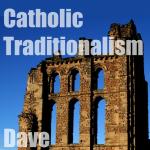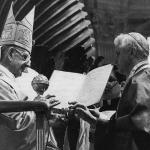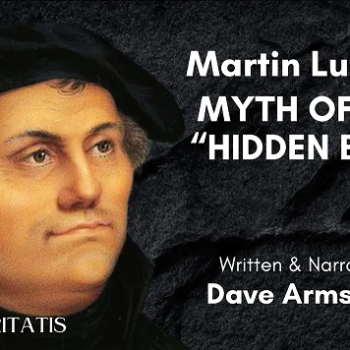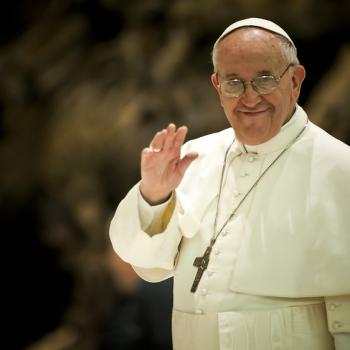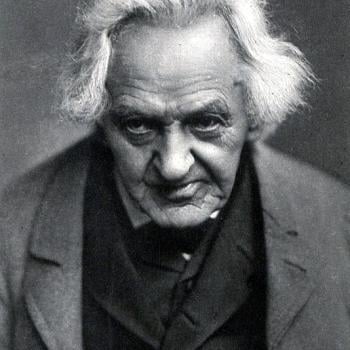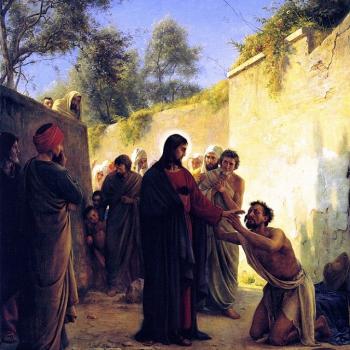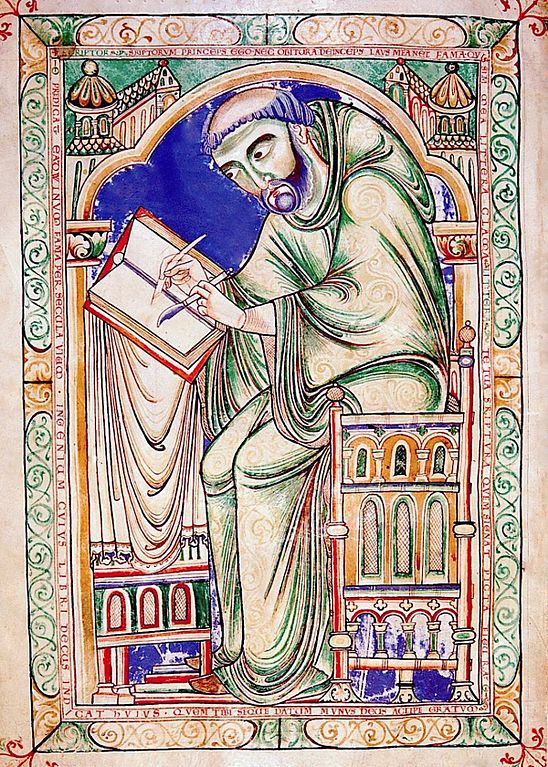
[see the Master List of all twelve installments]
Paolo Pasqualucci (signer of three of the endless reactionary-dominated “corrections” of Pope Francis), a Catholic and retired professor of philosophy of the law at the University of Perugia, Italy, wrote “‘Points of Rupture’ of the Second Vatican Council with the Tradition of the Church – A Synopsis” (4-13-18), hosted by the infamous reactionary site, One Peter Five. It’s an adaptation of the introduction to his book Unam Sanctam – A Study on Doctrinal Deviations in the Catholic Church of the 21st Century.
Pope Benedict XVI, writing as Cardinal Ratzinger, stated that the authority of Vatican II was identical to that of the Council of Trent:
It must be stated that Vatican II is upheld by the same authority as Vatican I and the Council of Trent, namely, the Pope and the College of Bishops in communion with him, and that also with regard to its contents, Vatican II is in the strictest continuity with both previous councils and incorporates their texts word for word in decisive points . . .
Whoever accepts Vatican II, as it has clearly expressed and understood itself, at the same time accepts the whole binding tradition of the Catholic Church, particularly also the two previous councils . . . It is likewise impossible to decide in favor of Trent and Vatican I but against Vatican II. Whoever denies Vatican II denies the authority that upholds the other two councils and thereby detaches them from their foundation. And this applies to the so-called ‘traditionalism,’ also in its extreme forms. Every partisan choice destroys the whole (the very history of the Church) which can exist only as an indivisible unity.
To defend the true tradition of the Church today means to defend the Council. It is our fault if we have at times provided a pretext (to the ‘right’ and ‘left’ alike) to view Vatican II as a ‘break’ and an abandonment of the tradition. There is, instead, a continuity that allows neither a return to the past nor a flight forward, neither anachronistic longings nor unjustified impatience. We must remain faithful to the today of the Church, not the yesterday or tomorrow. And this today of the Church is the documents of Vatican II, without reservations that amputate them and without arbitrariness that distorts them . . .
I see no future for a position that, out of principle, stubbornly renounces Vatican II. In fact in itself it is an illogical position. The point of departure for this tendency is, in fact, the strictest fidelity to the teaching particularly of Pius IX and Pius X and, still more fundamentally, of Vatican I and its definition of papal primacy. But why only popes up to Pius XII and not beyond? Is perhaps obedience to the Holy See divisible according to years or according to the nearness of a teaching to one’s own already-established convictions? (The Ratzinger Report, San Francisco: Ignatius, 1985, 28-29, 31)
For further basic information about the sublime authority of ecumenical councils and Vatican II in particular, see:
Conciliar Infallibility: Summary from Church Documents [6-5-98]
The Bible on Papal & Church Infallibility [5-16-06]
Authority and Infallibility of Councils (vs. Calvin #26) [8-25-09]
The Analogy of an Infallible Bible to an Infallible Church [11-6-05; rev. 7-25-15; published at National Catholic Register: 6-16-17]
“Reply to Calvin” #2: Infallible Church Authority [3-3-17]
“On Adhesion to the Second Vatican Council” (Msgr. Fernando Ocariz Braña, the current Prelate of Opus Dei, L’Osservatore Romano, 12-2-11; reprinted at Catholic Culture) [includes discussion of VCII supposedly being “only” a “pastoral council”]
Pope Benedict on “the hermeneutic of reform, of renewal within continuity” (12-22-05)
The words of Paolo Pasqualucci, from his article, noted above, will be in blue:
*****
8. The same Constitution Dei Verbum seems to eliminate the usual distinction between Tradition and Scripture (DV 9-10).
9. The concept of Tradition is never expressly defined; its relationship with Scripture is not made clear (DV 9), nor its relationship with the Tradition of the “Eastern Churches” (Decree Orientalium Ecclesiarum 1). In addition, there appears a concept of a “live” or “living tradition” (DV 8) which is nebulous and ambiguous, since, as Msgr. Gherardini emphasizes, “it lends itself to introducing every sort of novelty into the Church, even the most contradictory, as expressions of her life.”
#9 is easily disposed of and need not detain us very long. This is simply development of doctrine, which is expressly stated in section 8 of Dei Verbum:
This tradition which comes from the Apostles develop in the Church with the help of the Holy Spirit. (5) For there is a growth in the understanding of the realities and the words which have been handed down. This happens through the contemplation and study made by believers, who treasure these things in their hearts (see Luke, 2:19, 51) through a penetrating understanding of the spiritual realities which they experience, and through the preaching of those who have received through Episcopal succession the sure gift of truth. For as the centuries succeed one another, the Church constantly moves forward toward the fullness of divine truth until the words of God reach their complete fulfillment in her.
Development of doctrine has a long and noble, orthodox pedigree (as I’ve documented), including St. Vincent of Lerins, St. Augustine, and St. Thomas Aquinas. Pope St. Pius X condemned evolution of dogma, which is an entirely different thing from (Newmanian) development of doctrine. This holy pope enthusiastically endorsed Blessed Cardinal Newman’s thinking on development. For much more on this whole area, see my web page and book about it.
Of course legitimate Catholic tradition is living. That this has to even be argued at all is a great marvel and sad thing. It is the dead traditions of men that Jesus and Paul vigorously condemned. Jesus used phrases to describe this dead tradition in contrast to true sacred tradition, such as “your tradition,” “precepts of men,” “tradition of men” (see, e.g., Mt 15:3-9 and Mk 7:8-13). St. Paul draws this same distinction in Colossians 2:8 (“. . . empty deceit, according to human tradition, . . . and not according to Christ“).
#8 is quite a sweeping (and absurd) judgment about a beautiful portion of the Second Vatican Council: a statement that is as good and eloquent as any regarding the Catholic rule of faith, the “three-legged stool” of Bible, Tradition, and Church. Here it is, with the footnotes inserted, in green:
9. Hence there exists a close connection and communication between sacred tradition and Sacred Scripture. For both of them, flowing from the same divine wellspring, in a certain way merge into a unity and tend toward the same end. For Sacred Scripture is the word of God inasmuch as it is consigned to writing under the inspiration of the divine Spirit, while sacred tradition takes the word of God entrusted by Christ the Lord and the Holy Spirit to the Apostles, and hands it on to their successors in its full purity, so that led by the light of the Spirit of truth, they may in proclaiming it preserve this word of God faithfully, explain it, and make it more widely known. Consequently it is not from Sacred Scripture alone that the Church draws her certainty about everything which has been revealed. Therefore both sacred tradition and Sacred Scripture are to be accepted and venerated with the same sense of loyalty and reverence. (6)
[cf. Council of Trent, session IV, loc. cit.: Denzinger 783 (1501).] [link to Trent, Session IV]
10. Sacred tradition and Sacred Scripture form one sacred deposit of the word of God, committed to the Church. Holding fast to this deposit the entire holy people united with their shepherds remain always steadfast in the teaching of the Apostles, in the common life, in the breaking of the bread and in prayers (see Acts 2, 42, Greek text), so that holding to, practicing and professing the heritage of the faith, it becomes on the part of the bishops and faithful a single common effort. (7)
[cf. Pius XII, apostolic constitution, “Munificentissimus Deus,” Nov. 1, 1950: A.A.S. 42 (1950) p. 756; Collected Writings of St. Cyprian, Letter 66, 8: Hartel, III, B, p. 733: “The Church [is] people united with the priest and the pastor together with his flock.”]
But the task of authentically interpreting the word of God, whether written or handed on, (8)
[cf. First Vatican Council, Dogmatic Constitution on the Catholic Faith, Chap. 3 “On Faith:” Denzinger 1792 (3011).]
has been entrusted exclusively to the living teaching office of the Church, (9)
[cf. Pius XII, encyclical “Humani Generis,” Aug. 12, 1950: A.A.S. 42 (1950) pp. 568-69: Denzinger 2314 (3886).]
whose authority is exercised in the name of Jesus Christ. This teaching office is not above the word of God, but serves it, teaching only what has been handed on, listening to it devoutly, guarding it scrupulously and explaining it faithfully in accord with a divine commission and with the help of the Holy Spirit, it draws from this one deposit of faith everything which it presents for belief as divinely revealed.
It is clear, therefore, that sacred tradition, Sacred Scripture and the teaching authority of the Church, in accord with God’s most wise design, are so linked and joined together that one cannot stand without the others, and that all together and each in its own way under the action of the one Holy Spirit contribute effectively to the salvation of souls. [from the Holy See translation]
There is plenty here that distinguishes between Scripture and tradition. Similarities are stressed, but differences are also present (they are not presented as identical, at all):
“close connection and communication between”
“in a certain way merge into a unity and tend toward the same end”
“Sacred Scripture is the word of God inasmuch as it is consigned to writing under the inspiration of the divine Spirit”
“sacred tradition takes the word of God entrusted by Christ the Lord and the Holy Spirit to the Apostles, and hands it on to their successors in its full purity”
“. . . the word of God, whether written or handed on, . . . ”
“sacred tradition, Sacred Scripture and the teaching authority of the Church, in accord with God’s most wise design, are so linked and joined together that one cannot stand without the others”
“each in its own way . . . contribute effectively to the salvation of souls.”
In particular, I would highlight the sentence: “Consequently it is not from Sacred Scripture alone that the Church draws her certainty about everything which has been revealed.” This certainly expresses a sharp contrast between Sacred Scripture and sacred tradition. What would be some examples of doctrines which are not in Scripture at all (at least not explicitly or beyond all question)? The canon of Scripture, and the Bodily Assumption and Immaculate Conception of Mary are three: so I would contend.
The Bible never mentions which books ought to be included in the Bible. That was determined by Church tradition. Dei Verbum mentions this in section 8: “Through the same tradition the Church’s full canon of the sacred books is known . . .” Not all books are self-evidently inspired or self-evidently canonical. Sometimes, authors were not even aware that they were writing Holy Scripture (or that their writing was inspired by the Holy Spirit).
The Bible mentions a few examples of persons who went to heaven (like Enoch and Elijah) without having died (even bodily), so there are arguments for the Assumption from analogy, and Revelation 12 arguably strongly implies it, too, but there is no express statement of Mary’s Assumption.
Likewise, there is no explicit indication for Mary’s Immaculate Conception. It’s an inference. One can build a linguistic argument for Mary’s sinlessness (the essential idea of the Immaculate Conception) from Luke 1:28, and other analogies can be drawn, but there is no verse even remotely stating or even implying, “Mary was immaculate and sinless and also free from original sin from the moment of her conception.” But the Immaculate Conception, like the Assumption, is harmonious with biblical revelation. It doesn’t contradict anything in it. Catholics believe that the course of sacred tradition and centuries of pondering on Holy Scripture have revealed both doctrines to be true.
Therefore, it’s obvious on these grounds and others, that sacred tradition can be (and is, in Dei Verbum) distinguished from Sacred Scripture, since there are doctrines that were primarily or solely developed by the former and not explicitly present in the latter.
Arguably, Dei Verbum 9-10 draws a greater distinction between Scripture and Tradition than Trent, Session IV, in the sentence I have already focused on: “Consequently it is not from Sacred Scripture alone that the Church draws her certainty about everything which has been revealed.”
Trent didn’t phrase it that starkly. It simply affirmed: “this truth and discipline are contained in the written books, and the unwritten traditions . . .” It didn’t explain the exact relationship between the two. Vatican I cited this portion verbatim and didn’t really add to it. It was left for Vatican II to express more articulately (and in my humble opinion, in a more beautiful and moving manner). Vatican II made more clear both the distinction between sacred tradition and Sacred Scripture, and the commonalities.
The notions of “same divine wellspring” or “one sacred deposit of the word of God” was expressed in essence by St. Augustine (354-430):
Remember that one alone is the discourse of God which unfolds in all sacred Scripture, and one alone is the word which resounds on the lips of all the holy writers. (Enarrationes in Psalmos, 103, IV, 1: PL 37, 1378; cited by Pope Benedict XVI, Verbum Domini [2010], 18, footnote 64)
In fact, neither Trent nor Vatican II definitively dealt with the exact relationship between Scripture and tradition. Trent — contrary to much anti-Catholic polemics — did not dogmatize the “partim-partim” interpretation (i.e., that Catholic truths are revealed partly in Scripture and partly in tradition). Nor did Vatican II dogmatize the material sufficiency viewpoint. Catholics were free, then as now, to hold either.
Moreover, the idea of the “word of God” being a larger category, including both Scripture and tradition, was taken (as indicated by the footnote) straight from Vatican I in 1870: Dogmatic Constitution on the Catholic Faith, Chapter III: “Of Faith”:
Further, all those things are to be believed with divine and Catholic faith which are contained in the Word of God, written or handed down, and which the Church, either by a solemn judgment, or by her ordinary and universal teaching (magisterium), proposes for belief as having been divinely revealed.
Fr. Brian W. Harrison wrote about how nothing regarding the Catholic doctrine of tradition and the rule of faith had essentially changed between Trent and Vatican II. There is no discontinuity — let alone rupture — here. Neither council closed discussion on the issue, and neither went to the “extreme” of partim-partim, on the one hand, or required material sufficiency of Scripture on the other:
[S]ome Fathers were anxious to have a more general and explicit statement to the effect that Scripture and Tradition are two independent ways by which the one deposit of faith is transmitted to us. The essential question at issue was once again that of the ‘material sufficiency’ (or insufficiency) of Scripture. All the Council Fathers were agreed that Tradition must be taken into account when interpreting the Scriptures. But are all Catholic beliefs (prescinding from those concerning Scripture itself) at least materially contained in Scripture? Since it became clear quite early on that there was no possibility of arriving at a consensus on this disputed point, the drafting Commission, which was divided within itself over this issue, decided to avoid carefully either one opinion or the other, so as to leave the matter completely free for further discussion by theologians.
Nevertheless, a significant minority of Fathers continued to urge strongly that the text should explicitly dissociate the Church’s position from the ‘sola Scriptura’ principle of the Reformation; and as the debates drew to a close in September 1965, 111 Fathers asked the Commission to insert between the words diffundant and Quapropter in article 9 (dealing with the relation between Scripture and Tradition) a clause asserting that not every Catholic doctrine could be directly proved from Scripture. . . .
[B]y specifying Tradition as our means of knowing the complete canon of Scripture, the text clearly leans toward the view — although without rigorously implying it — that this revealed truth, at least, comes to us exclusively through Tradition. . . . Thanks to Pope Paul’s timely intervention, however, the final text stressed that the Church’s “certainty” about her articles of faith does not always come from “Scripture alone.” Without the insertion he requested, the text might well have been open to the ‘protestantizing’ interpretation that the Church may need to revise her certainty regarding a number of doctrines — including even solemnly defined ones such as the Blessed Virgin’s bodily Assumption or the legitimacy of venerating images — which, by common consent, are not taught clearly or explicitly in Scripture. We can thus see in Paul’s intervention in the conciliar proceedings an important historical instance of Peter ‘confirming his brethren in the faith’ (cf. Lk. 22: 32) . . . (“Paul VI on Scripture, Tradition, and Magisterium,” Roman Theological Forum: Living Tradition, November 2013)
In conclusion, Vatican II did not subvert the usual course of doctrinal development with regard to tradition and the rule of faith at all. It simply continued the ongoing theological analysis of the relationship between Scripture, tradition, and the Church.
***
Photo credit: Eadwine the Scribe at Work, c. 1147, anonymous; Canterbury, England [public domain / Wikimedia Commons]
***


